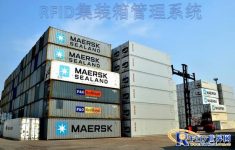
RFID container management solution
[ad_1]

1. Introduction to the system
The global circulation of goods uses containers as carriers, especially sea containers. There are about 2 million containers produced in the world every year, and more than 50% are produced in China. In 2004, the global container holdings were about 21.87 million. Container manufacturers and container transportation management companies undertake a large number of heavy statistical management tasks such as production and transportation, finished product transportation, and stacking storage. After the container leaves the factory, it is not possible to know the location and status of the container in real time, and whether it has reached the yard safely. Due to the complicated procedures of entering and leaving the yard, the consignment vehicles line up in long lines. In addition, find the designated container on the huge yard Very difficult, not only a waste of time but also error-prone. Since it is impossible to know the number of containers on the yard and the vacancies in real time, the utilization rate of the yard is invisibly low, and enterprise resources are wasted. At the same time, criminals use container smuggling cases to increase every year. After using RFID electronic tags, the electronic tags in each container will write the number of the container, which company it belongs to, the destination, the product code and other information. The problem can be traced to the source.
UHF of Shanghai Zhizhi CompanyRFIDThe technology can adapt to the harsh environment of the container production line and the metal box group in the storage yard, and real-time tracking of containers and consignment vehicles during the offline and transportation of finished products, and realizes the realization of containers (container production management) and consignment vehicles (automatic freight settlement) And the management of automatic yard management (container storage status). The RFID-based container management system uses UHF band products.
2. System composition
Reader, card issuer,electronic label, Antenna, on-board reader system, factory exit monitoring subsystem, yard automatic management subsystem, central monitoring subsystem.
Three, the system process

1. Write card in container workshop. When the manufactured finished container is off the production line, the corresponding container information, such as the container code, is written into the blank electronic label through the system software and the card writer, and the label with the written code is adsorbed on the container and read by the stacker truck of the production plant The device system confirms the container number and leaves the factory.
2. Read the container before delivery. Confirm that the factory container will be transported out of the production plant by trailer to the storage yard, and the reader installed at the factory’s export will read the container label information and trailer information (if the label reading fails, the export monitoring point staff can manually enter the box number) and transmit it to the factory In the monitoring subsystem, the system is uploaded to the central monitoring subsystem through the Internet network.
3. Reading at the entrance of the yard gate. When the container enters the yard gate, the reader at the yard entrance gate reads the container and vehicle tags, saves the vehicle information, container information and its matching relationship, arrival time, etc. to the yard management subsystem, and uploads it to the center at the same time Subsystem.
4. Place/pick up containers in the yard. After the containers enter the storage yard, the stacker truck system places the containers according to the stacking position allocated by the central subsystem. The vehicle-mounted reader automatically reads the information of the captured container, and the data interacts with the central database of the control room through wireless data transmission. After verification, the container is stacked to the position indicated by the system graphics. When picking up the container, the stacker truck system finds the corresponding container according to the graphic instructions, the reader reads the electronic tag on the container, and it is verified that the container should be removed after being picked up.
5. When the container is shipped out of the yard. The reader system at the exit of the storage yard reads the labels of the containers and vehicles that are out of the field, judges whether the containers should be out of the field, and after confirmation, matches the vehicle information and the box information, and saves the information and the departure time in the local database and the central database (MAS database). If the container information is successfully read, the staff will remove the label for recycling and enter the next round of applications.
Four, system characteristics
All equipment of the system meets the industrial-grade standards for dustproof, shockproof and high temperature. UHF electronic tag, stable reading and writing, long reading distance, suitable for identification of metal objects. The label has a magnet and can be directly attached to the container, which is easy to install and disassemble. In addition, the label can be recycled and reused, which saves business costs.
Readers are installed at key points such as the entrance of the container factory and the entrance and exit of the storage yard to realize dynamic reading of tags without stopping, which speeds up the delivery, transportation, and storage of offline products, improves the accuracy of information collection, and reduces staff Manual work in harsh environments.
[ad_2]


